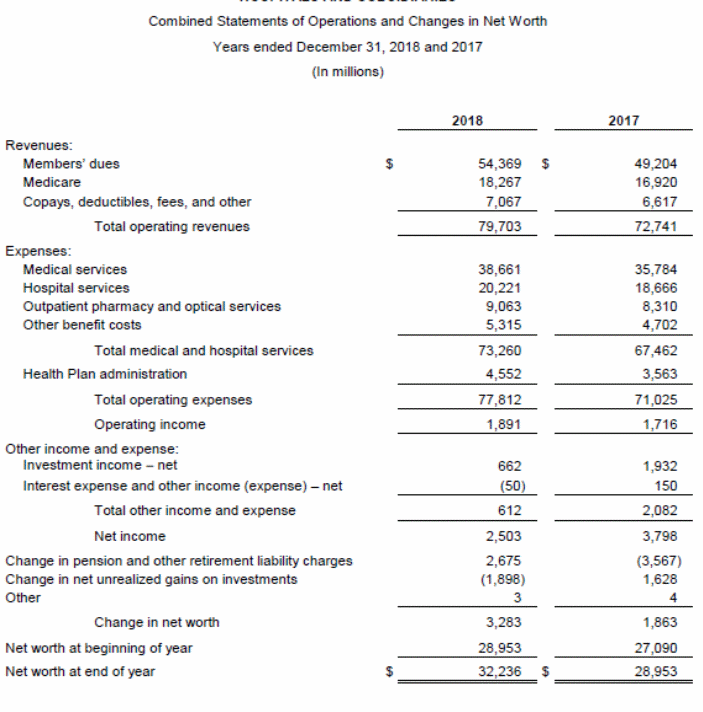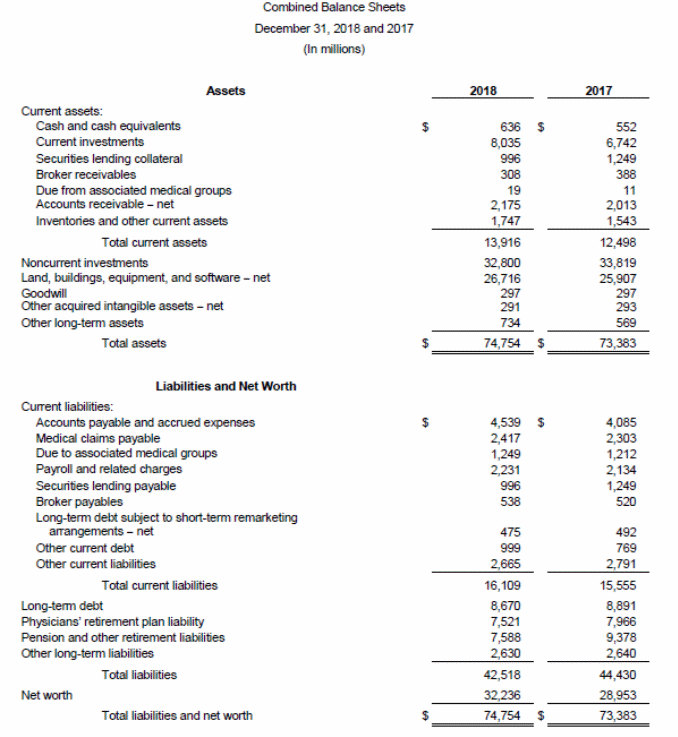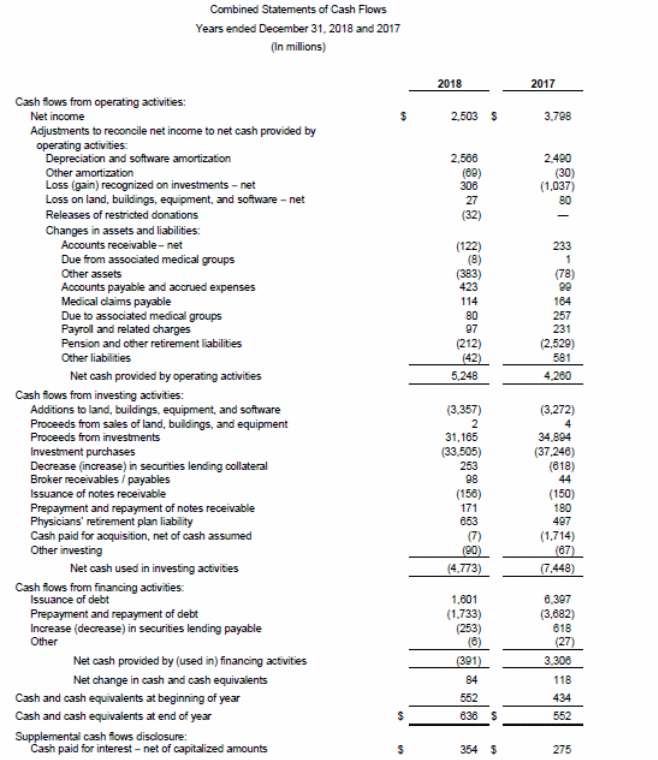Introduction
The US health care system and the specifics of the economic and social order have created the conditions for the operation and development of multiple health care organizations. Some of them are non-commercial, while others have a profit from their activities. However, regardless of purpose, all organizations must maintain financial records, and this information is often publicly available. This approach demonstrates the transparency of the organizations’ work and contributes to the development of the sector as a whole. In addition, the available financial information is a source for analysis that indicates the success or mistakes of the company. Consequently, this paper will study the Kaiser Permanente healthcare organization, its competitive advantages, and financial statements to determine the effectiveness of the company’s activities.
Company Background
Kaiser Permanente is one of the most prominent providers of healthcare services and health insurance programs in the United States. Currently, Kaiser Permanente has 12.4 million members in 8 states and the District of Columbia, providing benefits and quality healthcare (“Fast Facts,” 2020). Kaiser Permanente is often confused with The Kaiser Family Foundation; however, these organizations have nothing in common, since the first one is a commercial company, and the second is a charitable foundation.
Kaiser Permanente’s primary goal and mission is to create an environment where US residents can receive quality health care to prevent and treat disease. For this reason, Permanente Medical Group, which is an alliance of medical personnel and specialists, includes 715 offices and healthcare facilities, 39 hospitals, and thousands of doctors and nurses to provide quality services (“Fast Facts,” 2020). Kaiser Permanente was founded in 1945, and today is more than just an insurance company but an organization that uses research and innovation to improve its customer service (“Fast Facts,” 2020). For this reason, the company remains one of the most popular in the states where it operates because most of the clients are satisfied with the quality of services and a large number of offices where they can get professional help.
The company’s success is also indicated by the company’s profit growth. According to Kaiser Permanente’s announcement, its total operating revenues grew from $ 79.703 million to $ 84.538 million in 2018-2019 (“2019 financial results,” 2020). Unfortunately, this data can only be partially verified as the latest financial statements of the company are only available for 2018. Thus, Kaiser Permanente has high market success and customer loyalty due to its strategic and competitive advantages, which influence its profit and reputation.
Products of Kaiser Permanente
The main product of Kaiser Permanente is the health insurance programs and the various services that are included in them. The company offers insurance for individuals and families, people using Medicare and Medicaid benefits, and employees who are covered by the company. For example, people looking to purchase a customized plan can get a comparison of different sets of services and prices based on their health problems and preferences (“Shop plans.” n.d.). This feature helps potential clients to select a plan quickly and pay only for the necessary services to remain satisfied with the work of the company. For this reason, Kaiser Permanente also has support specialists and many offices so that clients can get additional help and information for choosing an insurance program.
In addition, the Kaiser Permanente website has information on Medicaid and Medicaid insurance requirements, as well as a list of services it includes, such as primary care, hospitalization, or medication. Thus, people who have social insurance can also get the services of the company, although they are financed by the state. However, Kaiser Permanente follows the law, so Medicaid and Medicare programs are sufficient to provide necessary healthcare services for most people. Besides, Kaiser Permanente offers charity insurance for citizens who cannot afford to purchase or receive social security coverage (“Shop plans.” n.d.).
The company also provides health insurance to people who receive funds from their employer to cover it, which significantly complements its customer base (“Shop plans.” n.d.). Thus, the result of Kaiser Permanente’s work is to provide its customers with a wide variety of healthcare services; however, the main product is health insurance.
Market and Legal Structure
For any business industry, competition is one of the key elements that play the role of a natural regulator against overpriced and low-quality products or services. The health insurance market also has these characteristics as it is a commercial industry, although it is partially regulated and directed by the government. However, a specific feature of the medical insurance market is high competition and, at the same time, its uneven distribution, since in some states, there are not enough insurance companies to maintain a competitive relationship.
However, Kaiser Permanente operates in a highly competitive environment, although it is at the forefront of most of the states it covers. So, in 2019, 74% of MSA-level markets were highly concentrated or had a significant number of insurance companies (“Competition in health insurance,” 2020). However, Kaiser Permanente has the largest market share for HMO products and top positions for other products in California, Washington, Colorado, Oregon, and Virginia (Guardado & Cane, 2020). Thus, while Kaiser Permanente must compete with many other firms, the company achieves success at this task.
The complexity of the insurance market is also in the fact that despite federal laws, each state has the right to set its own additional conditions for the operation of insurance companies. For example, a company must be licensed in each state of its operations and find qualified health care professionals and hospitals under state law that provides health care to the insurance company’s clients.
Consequently, the company essentially needs to build a new communication system, agreements, and market research and legislation for expanding its operations to new states, since health insurance cannot be sold or transferred to another state like most products. Thus, any insurance company needs to take precise steps and comply with all measures to enter a new market, even in the same country.
Another difficulty and advantage at the same time is the regulation of insurance companies work by federal laws. For example, The Affordable Care Act passed in 2010 by Barack Obama is one of the main laws that significantly expanded insurance coverage for the population, as well as established rules for insurance companies. For example, this Act prohibited companies from denying insurance to people if they already have an illness or setting a higher price for them, and also made a list of services that must be covered (Responsible Reform for the Middle Class, n.d.).
This rule is a disadvantage for companies, since, most often, the potential costs for their treatment are higher than the fees. However, ACA also has mandated all companies with more than 50 employees to cover their insurance and all individuals to buy insurance or apply for Medicare and expanded this program (Responsible Reform for the Middle Class, n.d.). Consequently, these rules have significantly increased the number of companies’ clients and, accordingly, their profits. Thus, all these facts demonstrate that the health insurance market is a complex structure, which is influenced by various environmental factors.
Competitive Position
The insurance market is developed and high-demanded in the United States, so Kaiser Permanente has many competitors. However, Kaiser Permanente is the second-largest insurance company in the United States in terms of profit (Grones, 2020). The company has such advantages as a wide network of hospitals and medical personnel who can provide professional help, comprehensive coverage of clients’ medical needs, and cooperation with trade unions. These features help the company retain customers and improve the quality of services.
First, cooperation with many offices, hospitals, doctors, and nurses allows Kaiser Permanente’s customers to have quick access to medical services. For instance, some insurance plans cover home care and specialist home visits, making it easier for people with reduced mobility to get professional help. In addition, Kaiser Permanente promotes a variety of preventive and diagnostic practices that cover a variety of health problems, for example, mental health, addiction treatment, or diabetes diagnosis. Consequently, this trait attracts clients who care about their health and undergo regular screenings, since the availability of various services makes it possible for them to be comprehensively monitored.
Another advantage of the company is in cooperation with trade unions. Unions have the power to influence the policy of the state in the field of health insurance. Thus, Kaiser Permanente and its healthcare specialist can suggest the most appropriate changes to benefit the industry and society. In addition, trade unions can offer the services of Kaiser Permanente to their members and bring new customers to the company in this way (“Our history,” n.d.).
On the other hand, Kaiser Permanente considers and knows the needs of workers due to its cooperation with unions and can provide them the best services. Consequently, this collaboration is beneficial for the trade unions as Kaiser Permanente takes employees’ interests into account in the payroll programs and unions are a source of clients for the company. Thus, these advantages allow the company to provide quality services and gain loyal customers to compete in the market.
Conclusion
Therefore, the way Kaiser Permanente operates, its success, and financial reporting demonstrate that the company uses the right strategies and approaches in its work. The first most accurate and significant parameter is the growth of the company’s profits, which is reflected in their financial reports and statements since after decades of existence, profit growth is an indicator of success. The second indicator is the share of the company in the states in which it operates, which in most cases is high or very high.
These numbers indicate that customers trust and use the company’s services and allow it to compete with other companies. However, this success of Kaiser Permanente is possible because of its strategic competitive advantages, such as a vast network of healthcare providers, a variety of services, and cooperation with trade unions. These features create value for products and a source of new customers, as well as maintain their loyalty. Consequently, despite the complexities of the US healthcare market due to legal regulations and high competition, Kaiser Permanente successfully manages its activities.
References
2019 financial results for Kaiser Foundation Health Plan, Hospitals. (2020). Web.
Competition in health insurance research. (2020). Web.
Fast facts. (2020). Web.
Grones, G. (2020). Top 10 health insurance companies in the US insurance business America. Web.
Guardado, J.R., & Kane, C.K. (2020). Competition in health insurance: Comprehensive study of U.S. markets. American Medical Association Division of Economic and Health Policy Research. Web.
Our history — and future — are deeply connected to labor. (n.d. ). Web.
Responsible Reform for the Middle Class (n.d.). The Patient Protection and Affordable Care Act detailed summary. Web.
Shop plans. (n.d. ). Web.
Appendix A
Financial Statement – 1

Appendix B
Financial Statement – 2

Appendix C
Financial Statement – 3

